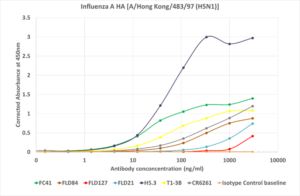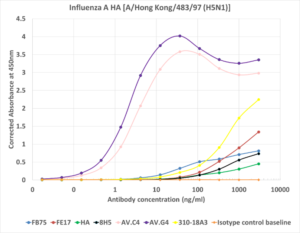The avian influenza A virus subtype H5N1 is a public health threat with the potential to cause disastrous effects to agricultural poultry flocks as well as serious illness and death in humans. Understanding its ecology, pathology and transmission is crucial to prevent these risks.
Absolute Antibody is committed to helping research on influenza A virus subtype H5N1. Our catalog offers a wide range of antibodies with different antigen specificities, cross-reactivities, and applications to support our customers in finding the most suitable reagents for their research.
H5N1 subtype
The natural reservoirs of influenza A virus are aquatic birds, in which the virus fully adapted to its host causing no signs of disease (Webster et al., 1992). The virus can be transmitted to domesticated birds, such as chickens and turkeys, through direct contact with infected waterfowl or infected poultry. In these hosts, the pathology of the disease can be extremely severe, especially with certain subtypes, such as H5N1, causing outbreaks of fowl plague. Further, this subtype has also been associated with human infections as monitored by the WHO. Currently, H5N1 subtype is not efficiently transmitted from person to person. However, because the virus undergoes continuous antigenic alterations it is possible that the strain becomes adapted to human horizontal transmission, causing a widespread outbreak of influenza infection (Thomas et al., 2007).

Fig 1. ELISA activity data of antibodies FC41 (Ab00149, green line), FLD84 (Ab00247, brown line), FLD127 (Ab00248, red line), FLD21 (Ab00250, blue line), H5.3 (Ab00798, purple line), T1-3B (Ab01106, yellow line), CR6261 (Ab02199, grey line) and an isotype control (Ab00102, orange line) binding to Influenza A HA [A/Hong Kong/483/97 (H5N1)].
Further subtyping of influenza A viruses is based on the antigenic properties of the envelope surface proteins HA and NA. Currently eighteen known HA subtypes (H1 to H18) and eleven NA subtypes (N1 to N11) have been isolated (Nuñez et al., 2019). HA plays a crucial role during virus entry into the cell to initiate infection and is thus a determinant of host range. HA binds to the sialic acid on the surface of the host cells. After binding, the virus enters the cell through receptor-mediated endocytosis. The HA ectodomain is composed of two regions, a globular head region and a stem region. The globular head contains the receptor-binding cavity as well as most of the antigenic sites of the molecule and is subject to continuous antigenic drift, while the structure of the stem region is more conserved. NA catalyzes the cleavage of virus particles from the sialic acid sites on the host cell, thus facilitating the spreading of the virus within the host. Similarly to HA, NA is highly mutable and undergoes antigenic drift (de Jong et al., 2006). The globular heads of HA and NA are the major target of neutralizing antibodies, as inhibiting the virus binding to target cells and spreading would reduce viral infection and disease.
Recombinant Engineered Antibodies

Fig 2. ELISA activity data of antibodies HA (Ab00151, green line), FE17 (Ab00150, red line), FB75 (Ab00148, blue line), 8H5 (Ab02100, black line), AV.C4 (Ab02203, pink line), AV.G4 (Ab02205, purple line), 310-18A3 (Ab02849, yellow line) and an isotype control (Ab00102, orange line) binding to Influenza A HA [A/Hong Kong/483/97 (H5N1)].
Figures 1 and 2 depict our ELISA data for the clones against Influenza A HA [A/Hong Kong/483/97 (H5N1)]. This study confirms the antibodies binding to the antigen and compares the respective affinity.
The antibodies in our catalog are available in different engineered formats, including rabbit and mouse formats for detection applications, co-labeling studies and animal model research; human IgG1 and IgM used in neutralization assays and as serological controls; scFv format with His-tags, for applications where antibody fragments are desirable and for site-specific functionalization; and human IgG1 and mouse IgG2b Fc Silent™ formats, which reduce binding of Fc receptors.
Please contact us if you would like to find out more about our anti-influenza A H5N1 subtype antibodies, their applications and the different formats.
Article complied by Dr. Lucia Lupica-Spagnolo, Absolute Antibody Junior Product Developer
| Catalog Number | Clone Name | Antigen | Cross Reactivity | Applications | Formats |
|---|---|---|---|---|---|
| Ab03636 | clone n.11 | NS1 | Influenza A virus H5N1, H1N1, H3N2 Influenza B virus | ELISA, WB, inhibition | Rabbit IgG Human IgG1 Human IgG1 Fc Silent™ scFv fragment (His) |
| Ab03635 | clone n.10 | NS1 | Influenza A virus H5N1, H1N1, H3N2 Influenza B virus | ELISA, WB, inhibition | Rabbit IgG Human IgG1 Human IgG1 Fc Silent™ scFv fragment (His) |
| Ab03634 | clone n.3 | NS1 | Influenza A virus H5N1, H1N1, H3N2 Influenza B virus | ELISA, WB, inhibition | Rabbit IgG Human IgG1 Human IgG1 Fc Silent™ scFv fragment (His) |
| Ab02849 | 310-18A3 | HA | Influenza A virus H5N1, H1N1 | ELISA, BLI | Rabbit IgG Human IgG1 Human IgG1 Fc Silent™ |
| Ab02205 | AV.G4 | HA | Influenza A virus H5N1 Does not cross-react with H5N3 | ELISA, WB | Rabbit IgG Human IgG1 scFv fragment (His) |
| Ab02199 | CR6261 | HA | Influenza A virus H1N1, H5N1 Subtypes H1, H2, H5, H6, H8, and H9 | NTRL, therapeutic | Rabbit IgG Human IgG1 Human IgG1 Fc Silent™ |
| Ab02100 | 8H5 | HA | Influenza A virus H5N1 | ELISA, Hemagglutination inhibition test, NTRL | Rabbit IgG Human IgG1 Human IgG1 Fc Silent™ Mouse IgG2a Mouse IgG2a – Fc silent |
| Ab02204 | AV.D1 | HA | Influenza A virus H5N1, H5N2, H5N3 | ELISA, NTRL | Rabbit IgG Human IgG1 scFv fragment (His) |
| Ab02203 | AV.C4 | HA | Influenza A virus H5N1, H5N2, H5N3 | ELISA, WB, NTRL | Rabbit IgG Human IgG1 scFv fragment (His) Mouse IgG1 |
| Ab00248 | FLD127 | HA | Influenza A virus H5N1 | ELISA, NTRL, RIA | Rabbit IgG Human IgG1 |
| Ab00247 | FLD84 | HA | Influenza A virus H5N1 | ELISA, NTRL, RIA | Rabbit IgG Human IgG1 |
| Ab00251 | FLD93 | HA | Influenza A virus H5N1 | NTRL | Rabbit IgG Human IgG1 |
| Ab00249 | FLD20 | HA | Influenza A virus H5N1 | NTRL | Rabbit IgG Human IgG1 |
| Ab00250 | FLD21 | HA | Influenza A virus H5N1 | NTRL | Rabbit IgG Human IgG1 |
| Ab03021 | A3 | HA cleavage site | Influenza A virus H5N1 Does not cross-react with H1N1, H7N7 | ELISA, IF, SPR | Rabbit IgG Human IgG1 Human IgM Mouse IgG1 Mouse Fab fragment |
| Ab00798 | H5.3 | H5 | Influenza A virus H5N1 | NTRL | Rabbit IgG Human IgG1 Human IgG1 Fc Silent™ |
| Ab01106 | T1-3B | HA | Influenza A virus H5N1 | ELISA, IF, hemagglutination inhibition test, microneutralization assays, virus titration | Rabbit IgG Human IgG1 Human IgM Mouse IgG2a Mouse IgG2a Fc Silent™ Mouse IgM |
| Ab00148 | FB75 | IHA | Influenza A virus H1N1, H5N1, H6N1, H9N2 Does not cross-react with H2N2, H3N2 and H7N7 | ELISA, NTRL | Human IgG1 Mouse IgG1 |
| Ab00151 | HA | HA | Influenza A virus H1N1, H5N1, H6N1, and H9N2 Does not cross-react with H2N2, H3N2 and H7N7 | ELISA | Human IgG1 Mouse IgG1 |
| Ab00149 | FC41 | HA | Influenza A Virus H1N1, H5N1, H6N1, and H9N2 Does not cross-react with H3N2 and H7N7 | ELISA | Human IgG1 |
| Ab00150 | FE17 | HA | Influenza A Virus H1N1 and H5N1 Does not cross-react with H2N2, H3N3, H6N1, H7N3 and H9N2 | ELISA | Human IgG1 Mouse IgG1 |
Latest News
Upcoming Events
Please join us at the following conferences and events. Stop by our booth, or get in touch to arrange a meeting.
See All Dates
 United Kingdom (UK)
United Kingdom (UK)